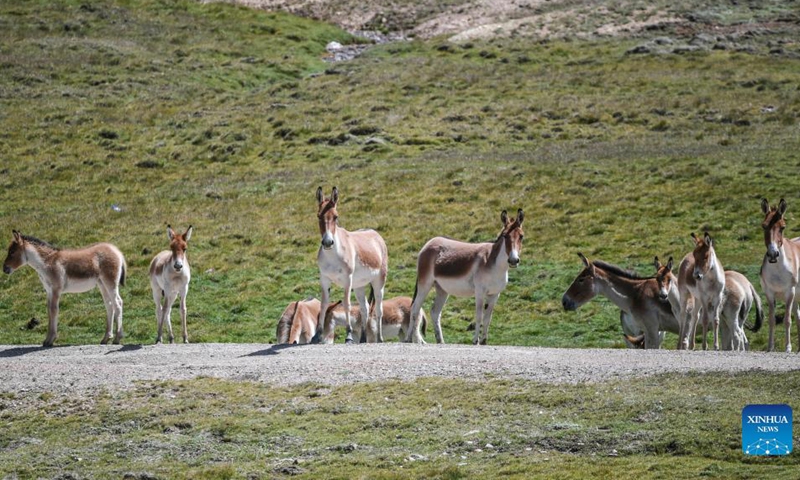China plans to build more national parks in key ecological areas like Xizang, Yellow River basin

Photo taken on Aug. 25, 2020 shows a herd of Tibetan wild donkeys at the Sanjiangyuan National Park in northwest China's Qinghai Province. Sanjiangyuan, meaning the "source of three rivers," is home to the headwaters of the Yangtze, Yellow and Lancang rivers. The ecological system has been steadily improving in recent years in the Sanjiangyuan National Park, making it a habitat of an increasing number of wild animals. (Photo by Pan Binbin/Xinhua)
China will build more national parks in important ecological areas, including the Qinghai-Xizang Plateau, the Yellow River basin, the Yangtze River basin and the sea, after considering China's ecological security needs and public concerns, Tang Xiaoping, chief of the Institute of National Park, said on Thursday.
China will launch a dynamic and open reserve mechanism for national parks to guide the establishment of national parks across the country, Tang said at Thursday's press conference on national parks.
China's national parks project has moved from the pilot to construction phase with the establishment of its first batch of parks, he said.
China announced the formal establishment of the first five national parks on the 15th meeting of the Conference of the Parties to the Convention on Biological Diversity (COP15), covering more than 230,000 square kilometers and conserving nearly 30 percent of the country's key wildlife species.
The five parks are Sanjiangyuan National Park in Qinghai-Xizang Plateau, Wuyi Mountain National Park in the provinces of Fujian and Jiangxi, Giant Panda National Park in Sichuan, Shaanxi and Gansu provinces, Northeast China Tiger and Leopard National Park in Jilin and Heilongjiang provinces, and Hainan Tropical Rainforest National Park in Hainan Province.
Tang said that national parks will be divided into core protected areas and general control areas. The core protected areas are only open to scientific research, investigation, monitoring and other activities, and the general control areas will be open to the public.
He said that there will be education bases, science bases, field monitoring stations and other facilities for science education and exploration.
In 2013, the central government put forward the national park system to establish a series of facilities and build a unified management system by 2020. Then in 2015, construction was approved for 10 pilot national parks to further explore the unified management of all facilities.
Chen Fahu, an academician of the Chinese Academy of Sciences and director of the academy's Institute of Xizang Plateau Research, told the Global Times on the sidelines of the COP15 that being located in the Qinghai-Xizang Plateau, Sanjiangyuan national park is one of the areas in the world with rich biodiversity, and is a source for alpine organisms, a water resource known as the "China water tower," and a significant ecological security barrier for the country.
The protection of animals, plants, mountains, lakes, glaciers, frozen earth and fish in Sanjiangyuan national park is very important, and the establishment of the park shows that China will implement more systematic and effective protection to biodiversity, Chen said.
Since the establishment of the pilot area of Sanjiangyuan park, park management has created ecological protection posts for local farmers which effectively coordinated the relations of the poverty alleviation of local farmers and ecological protection of the national park, he said, noting that the establishment of the national parks reflected the confidence of China in the construction of ecological civilization.



